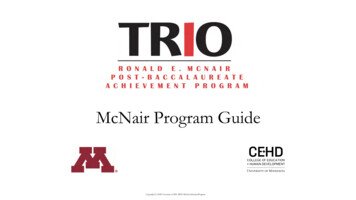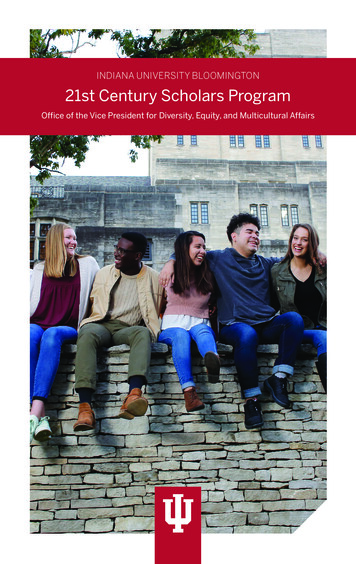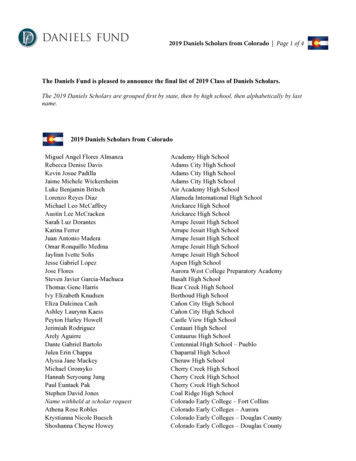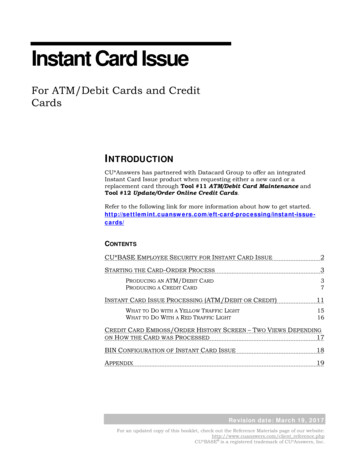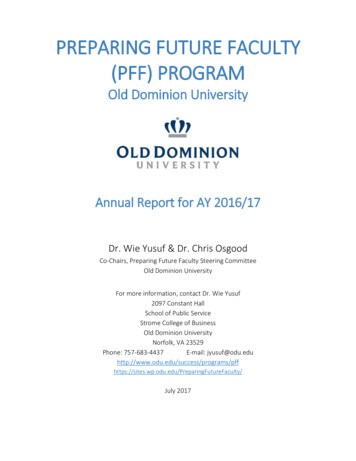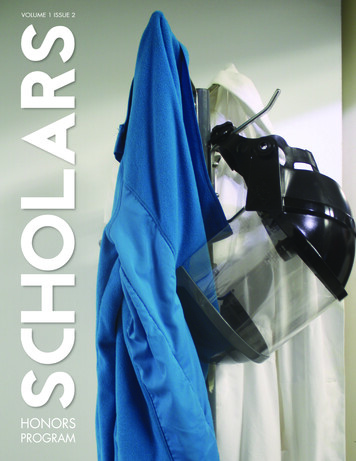
Transcription
VOLUME 1 ISSUE 11
2Felicia FrancisIt all Begins with Child-like Wonder:The Inspiration of the Hall of Science3Tamrah CunninghamA Gathering of Scholars4Ruchoma A. KaganoffRussell K. Hotzler, PresidentBonne August, Provost and Vice President for Academic AffairsHonors Scholars OrientationTamrah Cunningham5More than a Game:Sony’s Technology Lab6Pamela Brown, Associate ProvostHonors Scholars ProgramTamrah CunninghamJanet Liou-Mark, DirectorReneta D. Lansiquot, Assistant DirectorLaura Yuen-Lau, CoordinatorRoom to Grow:Exploring the Edison Labs8Tamrah CunninghamFounding and Managing Editor: Reneta D. LansiquotEditor: Tamrah CunninghamContributing Editors: Walter Rada and Khoreece H. MendozaThe Professor’s CornerScience, Suffering, Sustainability,and Scholarship: The Many Sides ofSuperstorm Sandy9Reginald A. BlakeArt Director: Mandy MeiGraphic Designers: Leonard Jules and Mandy MeiPhotographers: Oscar Diaz, Janet Liou-Mark, Rob Mark, Dree Morin, andLaura Yuen-LauFocused on the Future:The Brookhaven National Laboratory14Walter RadaHow to Prepare for Tomorrow Today:Undergraduate ResearchOpportunities16Ruchoma A. Kaganoff and Walter RadaCover Photo: SCIENCEOscar DiazKnowledge is Power.Ethics is Prudence.18Khoreece H. MendozaNASA Wants You!Khoreece H. MendozaPrintingDigital Imaging Center at City Tech.20contentsNEW YORK CITY COLLEGE OF TECHNOLOGYof The City University of New YorkTime to Unwind48914
Time to UnwindFelicia FrancisIt all Begins with Child-like WonderThe Inspiration of the Hall of ScienceIt’s the end of the semester: time to relax, catch up on some good novels and a well-deserved vacation. It is a goodfeeling knowing that you do not have to get up at 6am in the morning for an 8am class, no more test anxiety, and nomore assignments.Tamrah CunninghamWe all hold a childish wonder inlearning about how things work orwhy certain events take place. Whenwe see a rainbow, we want to knowwhat caused it to appear. Thesequestions and more were answeredon November 9, 2012, at the NewYork Hall of Science in Queens.The Honors Scholars Program helped its members kick off their winter break on December 20, 2012 with a day of funand a chance to reflect on what service means in our everyday activities. We had the chance to share a memorableexperience of bowling as members of the Honors Scholars Program, followed by an end-of-semester Christmas party.We started this fun-packed day with bowling at Maple Lane, a welcome moment to unwind, have fun and meet andmake future friends. It was a pleasurable feeling not to think about school activities for a bit.The Honors Scholars Program planned a much-needed day of fun and relaxation for its members. After our bowlingtrip, we had the chance to finish the day with a Christmas party shared with the Black Male Initiative members. Duringthis relaxed gathering, we shared carols, laughs and food. However, the most important purpose was the messageat this Christmas gathering: we were asked to meditate on the theme of “service.” Even though it was the end of thesemester and our time to relax, we should give of ourselves. The theme of “service” was emphasized by several guestspeakers, including Professor Liou-Mark who left us with an old Chinese proverb: “If you are planning for a year, sowrice; if you are planning for a decade, plant trees; if you are planning for a lifetime, educate people.” Prof. Liou-Markshared with the audience that the best thing we can do as people is giving of ourselves and that we should go beyondourselves in our everyday life. She shared her experience with us when, on vacation in Africa, she saw young childrenin school without school supplies. That experience compelled her to do something and give of herself by hosting abook-drive for these children.Composed of three floors, the NewYork Hall of Science focuses ondifferent aspects of science. The mainlevel has many stations such as anarea that explains how our peripheralvision works. Another explained therefraction of white light to form avisible rainbow. Not only were theresmall exhibits like these, but largerexhibits where you had to utilize yourwhole body like the hall of mirrors thatdistorted your shape and the antigravity mirror that gives the user thechance to feel like floating.The Honors Scholars Program gave us a chance to enjoy and unwind on our last day of school, but, most of all, ittaught us to give back to our community, because, as members of the National Society of Collegiate Scholars, weshould be committed to leadership and service to impact our communities.No more test anxiety and no more assignments.2SCHOLARSVOLUME 1 ISSUE 2throw different types of balls. Someexhibits were dedicated to the networkphenomenon, both physical, with ahuge pulley system that never formedthe same pattern depending on howyou turn the wheel, and biologically, byshowing the network that ants createGoing to theNew YorkHall of Sciencewas adazzling reminderof the amountof knowedgethat canbe obtainedby playing.After the chance to explore for awhile, the group of students had theopportunity to watch a live cow’s eyedissection. This demonstration gavethe viewers an in-depth look at theinner workings of an eye and manyrealized that a cow’s eyes are not thatdifferent from human eyes structurally.Other, less unsettling exhibits includedone explaining probability, oneexplaining the structure of DNA, andstations that allowed guests to buildand recreate their own molecules.There was even an exhibit that testeddepth perception.and have established to live. However,my favorite will always be a small littlestation that plays a beautiful piano piece:your goal was to follow the network ofcables to change the melody in order tocreate a new harmonizing piece.All of these were just on the first floor.On the upper levels, exhibits focusedon explaining kinetic energy and howthe human body’s muscles workedwhen performing different actionslike sports. There were also chancesto arm wrestle online and even theability to measure how fast you canGoing to the New York Hall of Sciencewas a dazzling reminder of the amountof knowledge that can be obtained byplaying. It is a scientific playground forall and reminds us that, once, all thegreat scientists were kids exploringnew ideas that others never thoughtpossible.3
A Gathering of ScholarsRuchoma A. Kaganoffachievers is happiness, and the secret to happiness is to begrateful. Dr. Armoza challenged students in the audienceto say “thank you” for three things each morning. This, shesays, is a powerful tool for achieving happiness and therebysuccess.In addition to Dr. August and Dr. Armoza, the audienceheard from the chapter advisors, Mr. Daniel Fictum, Directorof Student Life & Development, and Dr. Janet Liou-Mark,Professor of Mathematics and Director of the Honors ScholarProgram. Mr. Fictum encouraged students to becomeinvolved in NSCS activities, stressing that these would add toan enriching college experience.Each semester at the Induction Ceremony, NSCS introducesits Distinguished Members. This semester, the chapterofficers decided to give this honor to the faculty who offer theirtime, energy, and assistance to the student body in generaland specifically to those honors student who participate inresearch programs. They conduct workshops each semesterto develop students’ research and presentation capabilities.These professors, Prof. Jody Rosen (English), Prof. LaureenPark (Social Sciences), Prof. Maura A. Smale (Library), Prof.Justin Davis (Humanities), and Prof. A. E. Dreyfuss, spendhours of their time serving others, and this is a small token ofour gratitude towards them.As students, family and friends filed into the AtriumAmphitheatre on October 25, 2012, a palpable feeling ofexcitement filled the air. This event, the Induction ConvocationCeremony of the National Society of Collegiate ScholarsAugust, Provost and Vice President for Academic Affairs,in her welcoming remarks at the ceremony, highlighted thiswhen she reminded new inductees that the ideal of service inthe NSCS comes from the belief that those who are blessedFor a newer honor society that only recently celebratedits eighteenth anniversary, this has been quite a feat, andmany credit this to the NSCS’s focus on service. Dr. Bonne4In the final portion of the NSCS Induction ConvocationCeremony, new inductees were called on stage and giventheir NSCS pins as well as flower pens. After returning totheir seats, the president of the City Tech Chapter of NSCS,Tamrah Cunningham, led the new inductees, officers andother members in reciting the Oath of Membership.At the close of the ceremony, new members were called uponto participate in joining another academic community, that ofpublished scholars. As the inaugural issue of Scholars: AnHonors Scholars Program Sporadical was distributed, theachievement and accomplishments of students in the HonorsScholars Program reached an ever-wider audience, takingas its inspiration the innovation and creativity of the students.Honors Scholars OrientationTamrah CunninghamThe NSCS chapter atNew York City College of Technologywelcomed 193 new membersinto its ranks.(NSCS), marked the participants’ achievement in theiracademic pursuits, commitment to excellence, and desire toserve and excel in the collegiate and global communities. Atthis ceremony, the NSCS chapter at New York City College ofTechnology welcomed 193 new members into its ranks. Thisis a record high for the society’s City Tech chapter.The audience had the pleasure of listening to StudentGovernment Vice President Kevin Valencia provide a songdedication, which was followed by three new inducteessharing their Journey to Scholarship. Such stories werevaried, including a Radiologic Technology and MedicalImaging student who has returned to school after many years,an international student from the Dominican Republic whosevacation in New York led to her discovering a new home, anda Nursing student who has returned to school after a briefhiatus. All of these students share the underlying desire tosucceed, excel, and give back to their communities.and talented should use these talents to help others. Thisis a powerful message for new inductees and others in theaudience that those who excel in school or in other areashave special talents that can be used to help others.Next, Dr. Marcela Katz Armoza, Vice President of Enrollment& Student Affairs, shared a lesson on the secret to success.She explained that most people think that success leadsto happiness. However, according to some studies, happypeople tend to be successful. Thus, the secret to being highSCHOLARSIt’s about that time again: when the HonorsScholars Program welcomes new studentsinto its folds. In the beginning of everysemester, an orientation, hosted by theHonors Scholars Program Director ProfessorJanet Liou-Mark and the Coordinator LauraYuen-Lau, is held to introduce new membersto what the Honors Scholars is all about. Thissemester, the program welcomed 81 newstudents. It is also a time to welcome backreturning members and introduce them towhat is happening this semester as well. Sincethis time the orientation fell on Valentine’s Day,students were gifted with a sweet treat alongwith their information folder to celebrate theholiday.During the orientation, students are givena brief introduction on what the program isabout. Students are given the opportunityto work with faculty mentors on researchtopics that interest them. At the end of theVOLUME 1 ISSUE 2semester, students are to present their workat a two-day poster presentation session. Bycompleting the poster and attending all theworkshops that are geared to help studentsbetter their research and presentation skills,students are rewarded with Honors credit ontheir transcript. But there is more to the HonorsScholars Program than just academics.Every semester, there are a handful of tripsthat the students are welcomed to join andhave fun. There are a variety of trips availablefrom the Museum of American Finance toTheodore Roosevelt’s Birthplace. Not onlythat, this semester, there is a trip to Scranton,Pennsylvania at the end of the semester.There are plenty of chances to have fun andget to know other students in the program.The Honors Scholars Program is anunforgettable experience that is, without adoubt, a chance that you don’t want to miss.5
More than a GameTamrah CunninghamTechnology can be such a wonderful tool. Constantlychanging and evolving, it gives people the ability toexperience things that were once considered to be adream. And, on September 25, 2012, Honors ScholarsProgram members were able to embark on a journeythrough the technological paradise known as the SonyWonder Technology Lab in Manhattan.When you first enter, you are led to a computer stationto create a profile for yourself. By entering your name,favorite color and music, even your voice, you can useyour profile to activate the many exhibits and recordwhat you did during your time at the Wonder Lab. Onceyou log in to the system, you are given access to aninside look into technology you will probably have neverexperienced before.When you enter the lab, you are allowed to explore toyour heart’s content, and there are plenty of exhibitsshowing various branches of interactive technology.As you walk down the ramp, you can view some ofSony’s products in 3D floating in mid-air that dissolvesto show the inside when touched. There are also a fewstations that, when activated by your card, allow youto customize your image using various photo editingtools. When you finished, you can send your image toone of the large monitors around the lab so that othersmay view what you did. Going further down the laballows guests to view the timeline of the advancementof technology from the very first phone and television tothe latest in game hardware and medical technology.Past this exhibit is where it gets really interesting.Ever wondered what it would be like to be a surgeon?Well, one station allows guests to experience heartsurgery, not only the process, but the sensations aswell. Using haptic technology, guests can use a joystickto experience the sensation of using various medicalinstruments such as a saw to cut through the bodycavity, a pump to insert into a heart, even the feeling ofstitching up the body to complete open heart surgery.Near the virtual surgery station is the Robot Zone whereguests program mobile robots by setting up conditions6SCHOLARS“”The overwhelming content availablein this lab shows the ever-expandingworld of technology.using sensors. The robots, based on their programming, could move away when they near another robot or turn acertain way when they sense a certain color. You can even set up conditions that allow the robots to work together toaccomplish a goal.Lower in the lab are exhibits that vary from working together with a group of people to host your own news report to ananimation studio that walks the user through the steps to create his or her own animated story. A dance motion capturestudio enables users to choose their own avatar and dance to the music. Once finished, you can watch your avatarmimic your moves for the entertainment of those around you. Also on this floor, the Sony High Definition Theater plays30-minute short films in high resolution.Finally, on the last floor, the video game exhibit, the heart of Sony’s PlayStation 3 games, shows the progression of videogames over the years and gives participants the chance to create a personal racing track for a driving game. Also, amovie maker walks you through the process of film editing and a music mixing for the chance to edit a part of a songusing various musical instruments.There was so much to explore and so little time. The overwhelming content available in this lab shows the everexpanding world of technology, and it was exhilarating to walk through the many exhibits to experience everything. Notonly was it fun, but it was a great learning experience for all that attended.VOLUME 1 ISSUE 27
ROOM TO GROWEXPLORING THE EDISON LABSThe Professor’sCornerTamrah CunninghamDr. Reginald A. BlakePhysics DepartmentNew York City College of TechnologyNew York City Panel on Climate ChangeScience, Suffering, Sustainability and Scholarship“The Many Sides of Superstorm SandyStudents were able to walk through the labs thatThomas Edison used to revolutionize the world.It is human nature to dream, to useour imagination to create and inspire.These dreams are then used to changethe world. Starting from the simplest ofinventions like the wheel to the satellitesthat are circling our planet, humans arealways inspired to create somethingthat will help. On October 26, 2012, agroup of honors students were able totake a trip into the mind of one suchinventor, Thomas Edison. The studentsvisited the Thomas Edison NationalHistorical Park in West Orange, NewJersey, and had the chance to learnabout and explore the many ways thatThomas Edison inspired the world.lab and how much he adored the purebeauty of creating was palpable eventhough it has been decades sinceEdison had last stepped through thedoors to work.Taking a step into the past, the studentswere able to walk through the labs thatThomas Edison used to revolutionizethe world. In his Chemistry Lab, itwas possible to see all the chemicalsthat he used to create things such asthe alkaline rechargeable battery thatbecame one of his most profitableideas. The amount of time anddedication that Edison had spent in hisBut the heart of the Edison experiencewas the chance to explore the mainlab. It was here that hundreds ofEdison’s inventions were stored. Thelab contained large and small creations– from the famous phonograph thatplayed the first sounds ever recorded,to the first doll that could talk; theamount of things that were availableto view in this three floor lab was8Another treat that the students wereable to witness was the Black Maria.This structure was the first motionpicture studio that, in the past, patronswere able to enter and view the shortfilms played on the kinetoscope. Allguests had the chance to walk up tothis rotating, black house and peekinside to get a glimpse of what it waslike back in the early twentieth century.”incredible. However, it was not onlythe inventions that were on display, butthe rooms as well. Guests were ableto walk through the many rooms thatmade the inventions possible: the smallchemistry lab, the spacious musicroom where the sounds of singers andmusicians were recorded, and eventhe library where Edison kept his desk.Walking through Edison’s labs andviewing the places that he would goto work was inspiring to say the least.But all those inventions were not whatreally inspired me. It was the absolutejoy and love he had for creating allof those wonderful and beneficialthings. His goal was not just gettingthe positive results, but the negativeas well and learning from his mistakes.The dedication that he poured intocreating was the most inspiring thing,and, although he is not alive to see hisinventions evolve and inspire othersto create, the pleasure he had forinnovation permeates the visitors of hislabs to feel that same joy.SCHOLARSTROPICAL CYCLONESNorthern Hemispheric tropical cyclones are areas ofatmospheric low pressure that are characterized by anticlockwise, converging surface winds. These systemsform and intensify over warm tropical oceans that haveSuperstorm Sandy menacing the U.S. Easternseaboard (Adapted from NASA)sea-surface temperatures of at least 26 C (80 F). Ourrotating Earth produces the deflecting force (CoriolisEffect) that initiates the systems’ spinning circulation.When conditions are optimum, these cyclonic circulationscan become more organized, and their wind speedsVOLUME 1 ISSUE 2may increase. As cyclogenesis progresses, circulationcenters may become more defined, and these systemsare then upgraded to Tropical Depressions. As theymature and gain structure, they are characterizedby their central pressures and their accompanyingwind speeds. For wind speeds greater than 63 km/hr (39 mph), these systems are classified as TropicalStorms. For sustained wind speeds above 119 km/hr(74mph), these systems (in the Atlantic, Central Pacific,and Eastern Pacific regions) are officially upgradedand classified as Hurricanes. Hurricanes are furthersubdivided via the Saffir-Simpson scale. If a hurricanehas wind speeds between 119 – 153 km/hr (74 – 95mph), it is classified as a category 1 hurricane. If thewind speeds are between 154 – 177 km/hr (96 – 110mph), the hurricane is deemed a category 2 hurricane.Wind speeds between 178 – 209 km/hr (111 – 130 mph)make a hurricane a category 3 system. For wind speedsbetween 210 – 219 km/hr (131 – 155 mph), the hurricaneis a category 4 disturbance, and, for wind speeds above249 km/hr (above 155 mph), the hurricane is classifiedas a category 5 hurricane.The image below highlights the places on earth whereoptimum conditions for hurricane formation are usuallymet. Hurricanes generally form in the tropics, movewestward, then track northeastward over cooler oceanwaters where they then dissipate. The following imageshows the typical structure of a mature hurricane.9
SUPERSTORM SANDYStructure of a hurricane (Adapted from the UCAR/COMET program)Tropical Cyclone Tracks (Adapted from the UCAR/COMET program)Genesis and Destructive PathSuperstorm Sandy began as a typical tropical cycloneas described above, but ideal atmospheric conditionsnurtured, developed, and sustained it to become thehistorically devastating tropical/extra-tropical atmosphericengine that it was. What began as an area of disturbedweather south of Haiti and the Dominican Republic duringthe weekend of October 20 – 21, 2012 steadily advectedwestward and strengthened. By Monday, October 22,Sandy’s destructive path (Adapted from NOAA)102012, this convective region (tropical wave) developedinto Tropical Storm Sandy and thereby became the18th named storm, the tenth hurricane and the secondmajor hurricane of the 2012 Atlantic hurricane season.Tropical Storm Sandy later turned northward and made abeeline for Jamaica where it made landfall as a Category1 hurricane on October 24, 2012. After pummelingJamaica, the system gained strength over the warmwaters north of Jamaica, and, with this renewed vigor, itquickly strengthened to a Category 3 hurricane and paida visit to Cuba. After walloping eastern Cuba, hurricaneSandy weakened to a Category 1 hurricane and movedominously towards and across the Bahamas. As thesystem crossed over northern Bahamas, it took a slightnorthwestern turn and set its sights on the U.S. easternseaboard. Sandy roared up the U.S. eastern seaboard,and, on October 29, the system meandered as a posttropical cyclone with hurricane-force winds towards thenorth-northwest and came ashore near Brigantine, NewJersey, close to Atlantic City. The system impacted anextremely large area with strong winds and heavy snowfallall over southeastern West Virginia, northwestern NorthCarolina and extreme southwestern Virginia, lasting for 2448 hours. The higher elevations of these regions receivedone – two feet of heavy, wet snow. Bluefield, West Virginiarecorded the most daily and monthly snow for Octobersince 1959. Moreover, the entire West Virginia, NorthCarolina, Virginia region was shaken by winds between50 – 60 mph. See Sandy’s trail on the bottom left.Altogether, along the U.S. eastern seaboard, SuperstormSandy impacted twenty-four states from Florida to Maine,and, westward, it wreaked havoc from the AppalachianMountains to Michigan and Wisconsin. Its damage to NewYork and New Jersey was extremely severe. Storm surgein New York City on October 29 flooded streets, tunnels,and subways lines. In New Jersey, it clobbered BergenCounty, forced half the city of Hoboken into evacuation,and piled five feet of water into the streets of Moonachieand Little Ferry. The damage left in Sandy’s wake(approximately 75 billion) in the U.S. is second only tothe damage caused by Hurricane Katrina ( 108 billion).In the U.S. one hundred and twenty people died from theimpacts of Superstorm Sandy. In Canada, Sandy took twolives and left behind damage totaling over 100 million.In the Caribbean (Cuba, Dominican Republic, Haiti,Jamaica, The Bahamas), there were seventy-one Sandyrelated deaths and a damage estimate exceeding 3.5billion. The main agents of death and destruction weresevere winds, heavy rainfall, storm surge, and coastalflooding. Electricity was lost, fires erupted, roofs wereblown off, and hundreds of thousands of people wereevacuated and left homeless. The following image showsthe satellite and radar images of Sandy as it hovered overthe north-east United States.SCHOLARSMETEOROLOGICAL CHARACTERISTICSQUESTIONS ABOUT SUPERSTORM SANDYRemotely Sensed Images of Superstorm Sandy (Adapted from NOAA)Superstorm Sandy was indeed a special weathersystem. Despite its devastation, it has nowprovided geophysicists with many critical insightsin our quest to probe and to better understandthe science and wonders of the atmosphere. Thefollowing are some of the main characteristics andserious questions of the system that will be studiedfor decades to come:Superstorm Sandy had the lowest central pressure north of Cape Hatteras, NC at 943 mb;Superrstorm Sandy was massive in size, with an exceptionally large wind field that had tropical storm force windsextending some 500 miles away from its center; Why did the European model predict the storm track so much better than U.S. forecasting models? Why did the storm take the path it took? What atmospheric dynamics should have been better understood as precursors to the merging of Sandy with themid-latitude system? What role (if any) did climate change play in the development and the ferocity of Superstorm Sandy? TRI-STATE DESTRUCTION AND SUFFERING LEFT IN THE WAKE OF SUPERSTORM SANDYAside from its geophysical intrigue, the storm left unimaginable loss of life, property, and livelihoods in its devastatingwake, especially in and around the tri-state region. In the tri-state region, storm surge flooded streets, homes, subwaysystems, and tunnels. At least 37 people were killed in New Jersey, and at least 40 were killed in New York. People diedfrom downed electrical wire, from drowning, from falling trees, and from fire. In New York, the storm decimated StatenIsland, the Rockaways, Breezy Point, Red Hook, and Coney Island. Thousands of homes were damaged beyondrepair, and hundreds of thousands of people were left homeless. Thousands of sick, elderly, and disabled New Yorkerswere anxiously and disturbingly evacuated from hospitals, nursing homes, and high rise buildings. Massive trees wereblown down, millions lost power, the school systems and The New York Stock Exchange (NYSE) were all shut down—the first such closure for the NYSE since 1985 and the first two-day weather-related shut down of NYC since the greatblizzard of 1888. Strong storm surges (up to 13.88 feet) piled water from the East River into Lower Manhattan and theBattery tunnel. The storm produced the worst destruction to the NYC subway system in its 108-year history, and itprompted massive shortages of gasoline that led to long lines and the rationing of gas at gas stations throughout theregion, reminiscent of the gas crises of the 1970s. Notwithstanding many courageous acts of heroism, bravery, anda contagious spirit of volunteerism, an unshakeable, troublesome and disturbing cloak of misery, frustration, despair,anger, and gloom gripped (and in many cases still grip) thousands of residents throughout the region.Proposed storm surge protection barrier (Adapted from the Business Insider)VOLUME 1 ISSUE 211
SUSTAINABILITY AND POLICYGEOSCIENCE SCHOLARSHIP CRISESA comprehensive assessment of a historical, natural phenomenon of the scale, scope, and size of SuperstormSandy offers both unique challenges and elusive opportunities. Atmospheric phenomena of Sandy’s magnitude andintensity beg the question of how we can reduce our vulnerability to future storms while simultaneously enhance ourresilience and adaptation to climate change. As NY and NJ move into the rebuilding phase in the aftermath of thestorm, issues about scientific uncertainty, engineering, planning and policy, economics, and equity will arise andmust be resolved. Frank discussions about 1) extreme storm events and climate change, 2) the region’s vulnerabilityto future extreme events, and 3) challenges and opportunities of potential adaptation strategies must be held.For progress on these issues to be made, theadaptation and mitigation strategies as studiedand reported by Mayor Bloomberg’s New YorkCity Panel on Climate Change (NPCC) need to beimplemented.These strategies include:Cons: Costs, partial areal protection, role of high winds andinland precipitation, environmental impacts, and socialissuesOther post-Sandy adaptation/mitigationmeasures and policy may include:ActionsEnhancing existing adaptation and mitigationprogramsRaising sidewalk subway air ventsPlanning – Engineering and Ecological ApproachesNYC DEP Climate Change Integrated ModelingProject (CCIMP) analyzing climate impacts on NYCwater supplyNYC DEP study results of the impacts of rising sealevel on Wastewater Pollution Control Plants(WPCP), tide gates and other structures; planningto raise pumpsWetlands programs(e.g., Staten Island Blue Belt)Standards and RegulationsNPCC recommendation to change 1/100 yearfloodplain standardsThe Role of Urban DesignMitigationReduce magnitude of long-term risksSurge Barriers Pros: Long-term large-area facility to deal with increasingrisks of storm surge and rising sea-levels Flood walls in the subways, water pumps at airports,and sea barriers along the coast;Short- and long-term protections in transportationand with building codes;Improvements in insurance coverage and ways tofinance those improvements;The use of natural barriers to protect New YorkHarbor and Long Island;Roll-down gates and i
Scholars Program welcomes new students into its folds. In the beginning of every semester, an orientation, hosted by the Honors Scholars Program Director Professor Janet Liou-Mark and the Coordinator Laura Yuen-Lau, is held to introduce new members to what the Honors Scholars is all about. This semester, the program welcomed 81 new students.
